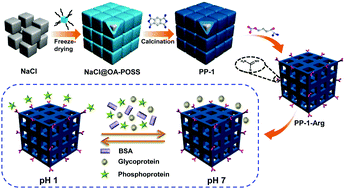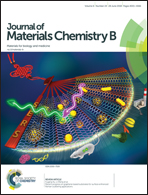Discrimination and highly selective adsorption of phosphoproteins and glycoproteins with arginine-functionalized polyhedral oligomeric silsesquioxane frameworks†
Abstract
The crosstalk between phosphoproteins and glycoproteins causes many difficulties in their selective isolation/enrichment from biological samples. This issue is of high significance in proteomics study, but thus far, it has not received proper attention. Herein, an arginine-functionalized polyhedral oligomeric silsesquioxane (POSS) framework, PP-x-Arg (x = 0, 1, 2, … denotes the amount of salt in preparation), was developed by combining salt-templated thermal polymerization of POSS and pyromellitic dianhydride (PMDA) with post-modification using arginine. PP-x-Arg possesses a porous nanostructure and abundant functional groups, namely, guanidine and zwitterionic groups, enabling the selective adsorption of phosphoproteins or glycoproteins via specific phosphate–guanidine affinity or hydrophilic interaction between PP-x-Arg and glycoproteins, respectively. In particular, the adsorption selectivity exhibited by PP-x-Arg can be easily regulated by adjusting the pH values of the adsorption medium. The PP-x-Arg framework was further employed for the discrimination and isolation of phosphoproteins and glycoproteins from biological samples.



 Please wait while we load your content...
Please wait while we load your content...